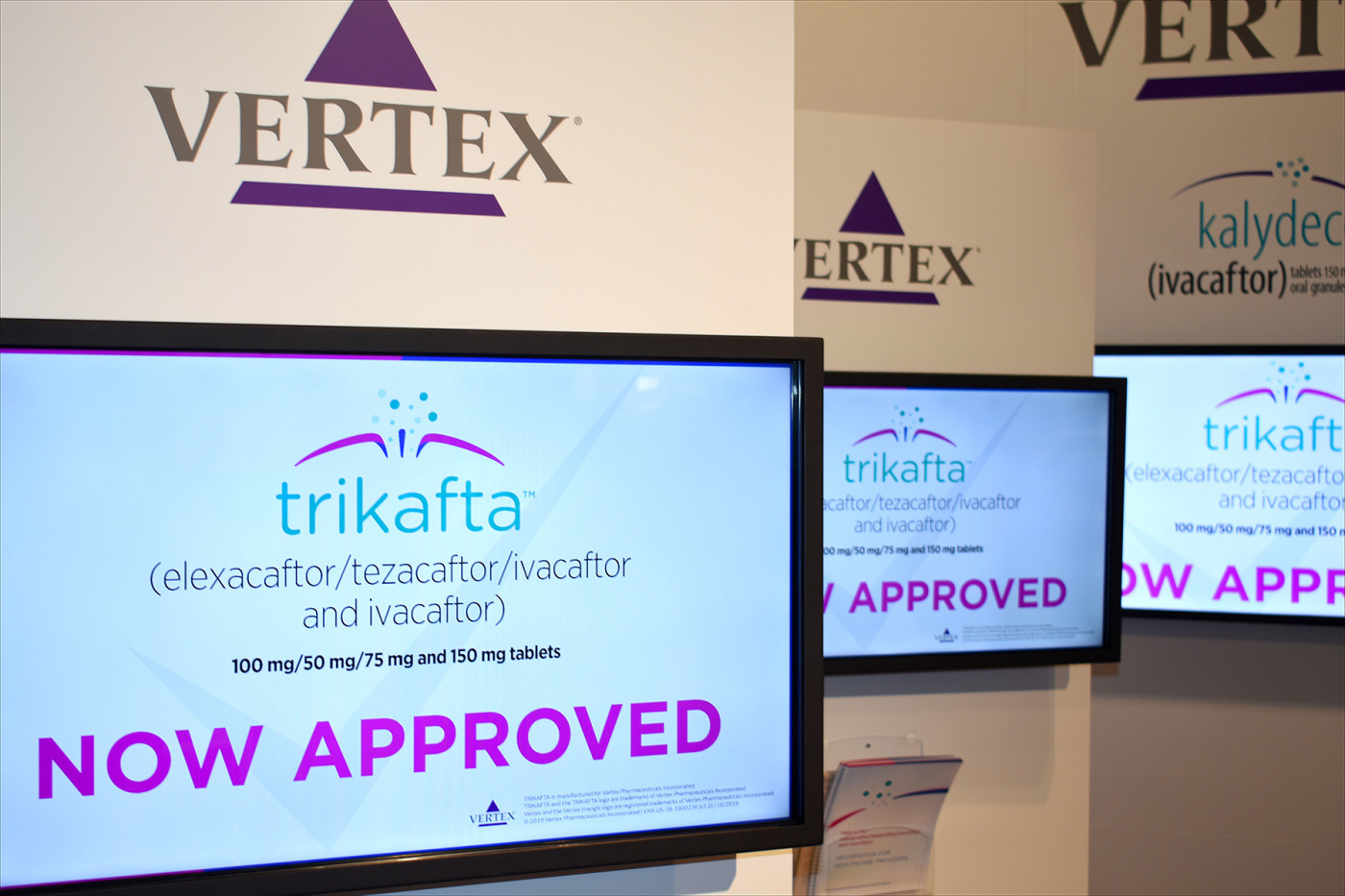PROMISE Study Examines Trikafta Use Among CF Patients

Vertex display celebrates the recent approval of its Trikafta therapy for CF. (Photo by Larry Luxner)
In the seven months since Vertex Pharmaceuticals’ triple-combo therapy Trikafta (elexacaftor/tezacaftor/ivacaftor) hit the market, people with cystic fibrosis, their doctors, and the Cystic Fibrosis Foundation (CFF) have all given the drug high marks for effectiveness.
Trikafta, a CFTR modulator, is intended to treat CF patients with at least one copy of the F508del mutation of the CFTR gene, which accounts for about 90% of all people with the disease.
“I’ve been more stable than I ever have been in my adult life,” said Meranda, a CF patient who’s been on Trikafta for nearly two years as part of a study. (She spoke on the condition her last name not be disclosed.) “I know of a handful of people who had to stop due to side effects. It’s certainly not a perfect therapy in that there are some difficult side effects for many. However, it has been very efficacious with improving symptoms. The response is certainly individualized,” she said.
JP Clancy, MD, the CFF’s vice president of clinical research, said he’s “very excited” by what he’s seen of the newest Vertex therapy so far.
“We don’t know, but I certainly have every reason to believe life expectancy will jump with Trikafta,” Clancy told Cystic Fibrosis News Today in a phone interview. At present, a baby born with CF in the U.S. can expect to live to 47 — a dramatic leap from when the CFF was founded in 1955. Back then, infants with CF rarely made it to their first birthday.
“We certainly want all CF patients to be on drugs that treat their cause of CF,” Clancy said. “What we’ve heard from patients and families has generally been very positive. Patients specifically report improvements in their respiratory symptoms, with reduced cough and reduced mucus production, and improved pulmonary function and energy. They generally feel much healthier.”
One such patient is Vincent Donato, who had tried two other Vertex therapies — Orkambi (ivacaftor/lumacaftor) and Symdeko (ivacaftor/tezacaftor) — without much success. He began taking Trikafta nearly four weeks after its October 2019 approval by the U.S. Food and Drug Administration (FDA).
“There are no words to describe the feeling of taking deep breaths and having it travel through your entire body,” Donato wrote on the CFF’s community blog. “That weekend, I found myself getting air into parts of my lungs that I haven’t felt since I was a child.”
PROMISE study
The nonprofit foundation is leading PROMISE — an observational study (NCT04038047) of 490 patients on Trikafta aimed at learning more about its biological and clinical effects. The study began immediately upon Trikafta’s FDA approval for all CF patients 12 and older.
“What’s interesting is that this study looks at all different facets of CF, not just lung function,” Clancy said. These include patient-reported outcomes and basic quality-of-life measures as well as endocrine measures such as diabetes and bone health. Also studied is microbiology, lung inflammation, gastrointestinal health, blood sugar, and liver function.
The CFF team performs its measurements right before patients start Trikafta, and then at several timepoints including at one month, three months, six months, 12 months, and 24 months after starting treatment.
Patient recruitment for PROMISE, which is costing the CFF about $10 million, began just as the COVID-19 pandemic disrupted life across the U.S. and around the world.
“That study has obviously been impacted somewhat by COVID-19. But we do have baseline and one-month drug data for every patient,” Clancy said. “The plan is to do this study for two years, and we are adapting to COVID-19 with some virtual visits and also exploring using telehealth readouts like home spirometry to measure lung function. We would provide patients with handheld spirometry devices, which have advanced a lot over the years. At the moment, most study sites cannot do spirometry in clinic because of COVID-19 restrictions.”
Trikafta’s price tag
Vertex said its latest therapy is proving to be a financial bonanza. Just over 11,400 CF patients now take the treatment, which retails for $311,500 a year.
“The U.S. launch of Trikafta has been remarkable, with the majority of eligible patients having now initiated treatment with this medicine,” Reshma Kewalramani, MD, Vertex’s president and CEO, said in an April 29 press release.
“This strong interest reflects Trikafta’s substantial benefits for patients and has resulted in significant increases in revenue to support continued investment in both our internal pipeline and business development efforts to support future growth,” he said.
According to Vertex’s first quarter financial results, Trikafta’s U.S. sales in the first three months of 2020 came to $895 million. That far exceeds the $620 million in combined sales of Orkambi, Symdeko, and another CFTR modulator, Kalydeco (ivacaftor), during the same period. At least one analyst predicts that Trikafta could hit $4.6 billion in sales by 2023 and $6.6 billion by 2025.
In early May, the Institute for Clinical and Economic Review (ICER) gave Trikafta an “A” for effectiveness — its highest evidence rating possible — yet said the drug should cost between $67,900 and $85,500 per year to be in line with the benefits it provides.
“Trikafta is likely to alter the course of disease for the majority of patients with CF, transforming their lives and the lives of caregivers,” ICER chief medical officer David Rind, MD, said in a press release. Yet “the prices set by the manufacturer — costing many millions of dollars over the lifetime of an average patient — are out of proportion to their substantial benefits,” he said.
Exploring side effects
Clancy said that along with Trikafta’s benefits, the CFF also is exploring the unpleasant side effects of the therapy, such as weight gain, anxiety, and depression.
“We’re trying to better understand weight gain in patients who had been taking a high-fat diet. We may find that as their CF is better treated, those high-calorie diets might need to be dialed back. These patients probably use their calories much more efficiently now,” he said. “We also want to learn more about anxiety and mental health in those beginning Trikafta.”
Clancy suggested a few reasons why a therapy like Trikafta has such a profound psychosocial impact on people who are on the therapy.
“It does create potential challenges for patients who may have to rejoin the workforce. They may be concerned that they don’t have the skills, because in the past they had to dedicate so much time and effort to staying well,” he said. “But we don’t know yet whether the drug actually brings out symptoms.”
In many cases, just talking about the side effects can benefit CF patients.
Meagan Helmick, a Virginia college professor with CF who’d been on Symdeko for two years, said her lung function shot up by 15% within two weeks after switching to Trikafta. For the first time since 2012, she was able to run an entire mile without stopping.
Helmick also gained 10 pounds, leading her to struggle with feelings of guilt, given Trikafta’s advantages over earlier therapies. She decided to consult her CF care team about it.
“When I told my doctor, he listened. He immediately reassured me that this was expected,” Helmick wrote on the CFF community blog. “I was relieved to find out that I wasn’t alone in my concern about my sudden weight gain, and that bringing the topic up to my care team didn’t mean that I wasn’t grateful for all Trikafta has done for me.”









